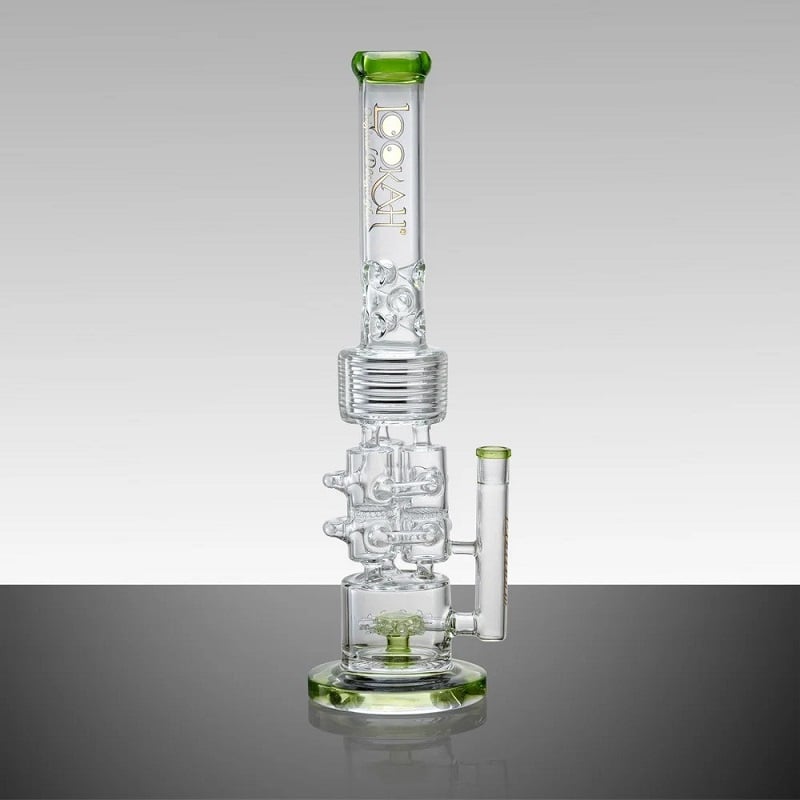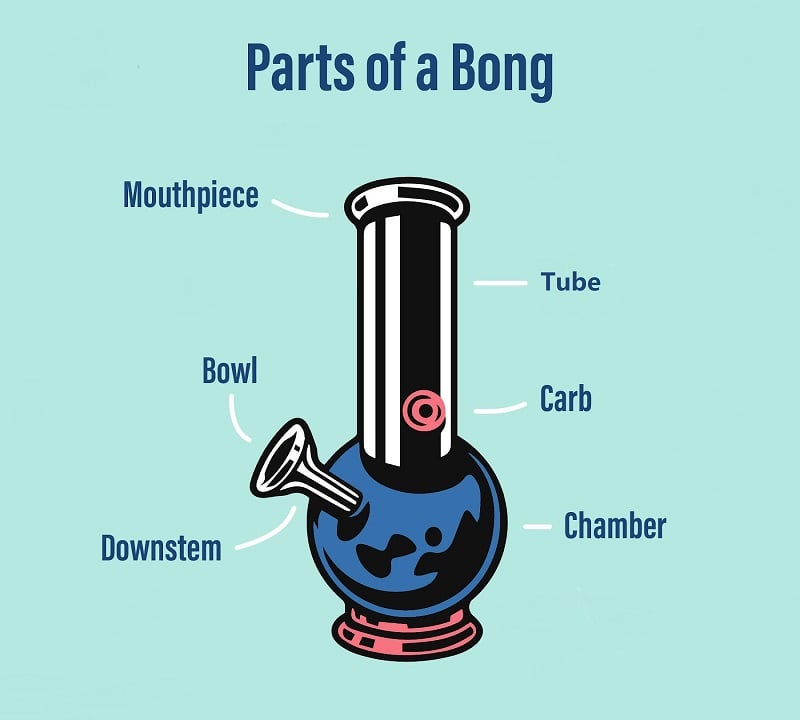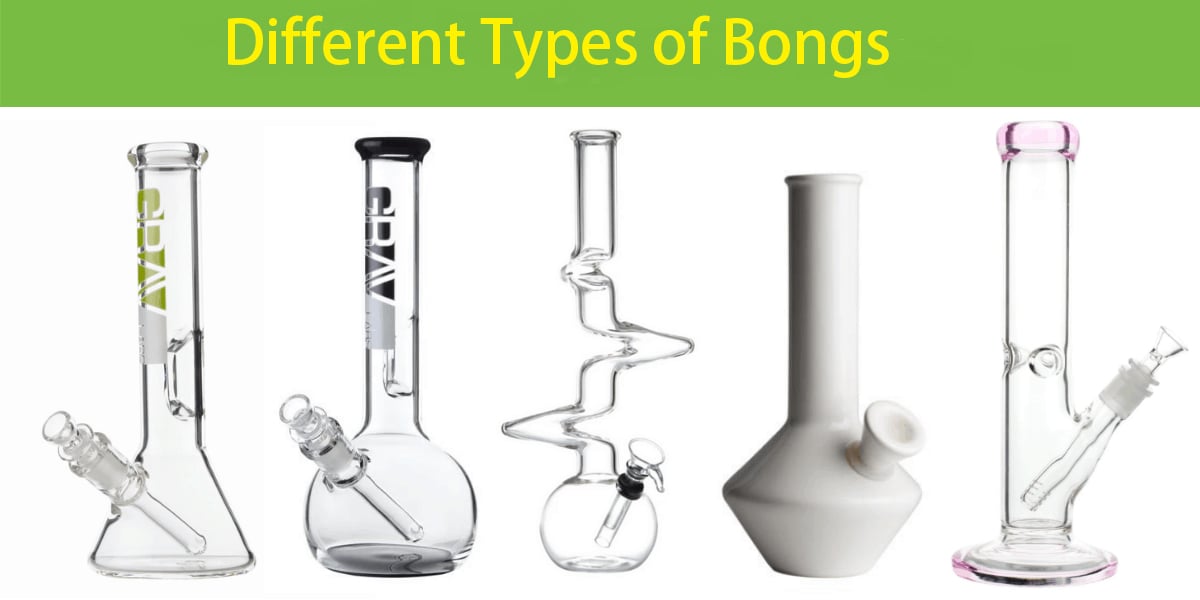What is a bong? Different Types of Bongs in Brief

If you are looking for a filtered, cooler and smoother smoking experience, then a bong is what you need.
For generations, bongs have been the charming companions of pot enthusiasts, captivating with their simplicity and effectiveness.
What is a bong? How to use a water bong? Which bong type should I choose? If you’re new to the bong world, this guide will walk you through everything there is to know about bong.
In addition, bongs have evolved in shapes, materials, and functions over the years, keeping pace with all these innovations can be hard to keep up with. That’s why we’re here to give you the bong breakdown.
What is a bong?

A Bong is commonly defined as a device, generally used for smoking pot flower, tobacco, or a myriad of other herbal substances, which uses water as a filtration system.
Although these devices vary in size, shape, and complexity… the one thing they all have at least 6 parts in common: bowl, carb, downstem, water chamber, tube, and mouthpiece.
This type of smoking device is known for cooling the smoke, providing a smoother, less harsh hit.
History of the Bong
Did you know that bongs (officially called ‘water pipes’) date back to the days of Emperor Akbar?
For thousands of years, civilizations smoked things like opium and tobacco through clay, bamboo, and animal horn bongs.
The term bong actually comes from the Thai word “Baung” – a cylindrical smoking tube made of wood or bamboo.
Surprisingly, during the Vietnam War era American soldiers discovered the “Baung”. The water pipe concept migrated back to the US with the soldiers.
The glass bongs or "water pipes" you see today were originally invented by Bob Snodgrass during the 1960s and 1970s.
What are the parts of a bong?

Bongs come in many shapes and sizes. Some are simple while others can be quite fancy with extra features like ice catchers or percolators that make the smoke even smoother.
Bongs come in many shapes and sizes. Some are simple while others can be quite fancy with extra features like ice catchers or percolators that make the smoke even smoother.
Although these devices vary in size, shape, and complexity… the one thing they all have at least 6 parts in common: bowl, carb, downstem, water chamber, tube, and mouthpiece.
1. Bowl
The bulb-like attachment is the bowl, and that's where you put the dried and grounded weed before you combust it. You can remove it and allow it to function as a slide.
2. Carb
“Carb” or carburetor (generally a pull or a slide) – a hole in the side of the base to create clean air flow and clear the tube.
Most times, this means simply lifting the bowl off of the downstem.
3. Downstem
The downstem is a long, thin, removable tube that extends from the bowl into the water chamber.
It directs the smoke from the bowl into the water, allowing it to be filtered and cooled.
4. Water Chamber
The water chamber is the main body of the bong. It holds the water used for filtration and cooling. This chamber can come in different shapes and sizes.
5. Tube
This is the chamber that ends in the mouthpiece. It fills with smoke when you inhale.
6. Mouthpiece
It is pretty self-explanatory—that’s where you suck in.
7. Percolator
In fancier models, the neck of a bong may also house an ice-catcher, where you can add a few ice cubes, or a percolator for additional smoke filtration.
Both of these modifications help produce a smoother hit that’s easier to inhale.
How to use a water bong?
If you are new to using water bongs, You can simply follow the following 5 steps:
Step 1: Pour water into the bong submerging the downstem.
Step 2: In the bowl, pack some freshly ground dried buds. When you light the weed, it combusts.
Step 3: Place your mouth on the mouthpiece before you light the bowl and start inhaling slowly.
Meanwhile, as you inhale, the water in the bottom of the bong bubbles.
The smoke rises up through the water and then the chamber and tube.
Step 4: Once the chamber fills up with milky white smoke, you can remove the bowl, and let go of the carb. If yours has a slider, then pull it instead.
Step 5: Inhale the smoke from the chamber and return the slider when you exhale, ideally until you “clear” the neck of smoke.
Benefits of Using a Bong for Smoking
While some may argue that using a water bong is simply a matter of personal preference, there are actually several benefits to using one.
First and foremost, the water in a bong helps to filter out harmful toxins, tar and particles from the smoke, making it cleaner and smoother to inhale. This can be especially beneficial for those who have respiratory issues or are sensitive to harsh smoke.
Additionally, the bong water also acts as a cooling agent, reducing the temperature of the smoke and making it less harsh on the throat and lungs. This can make the smoking experience more enjoyable and less uncomfortable.
Furthermore, Compared to rolled joints and hand pipes, Bongs gets you extra high with the same amount of weed. A lot less smoke gets lost, so the cannabinoids reach your blood more and more effectively, which means you get higher.
Finally, using a water bong can also be a more visually appealing and fun way to smoke, as the bubbling and filtering action of the water can be entertaining to watch.
Overall, the benefits of using water in a bong make it a popular choice among smokers who are looking for a cleaner, smoother, and more enjoyable smoking experience.
Different Types of Bongs
There are a number of ways to make a water pipe. When it comes to buying a bong, you’ll want to consider two factors, the design of the bong, and what the bong is made out of.

Different types of Bongs By Material
The most common materials that make up most bongs include glass, silicone, acrylic, and ceramic. Each material comes with its own pros and cons.
1. Glass Bongs
A glass bong is a classic and most popular choice due to its aesthetic appeal and relative affordability.
Glass is non-porous, antibacterial, and odour-neutral. These are the reasons that glass bongs provide a cleaner, more pure taste than other materials.
Another advantage of glass is that it doesn’t conduct heat as much as some other materials, and it feels pleasant in the hand. In other words, it’s just the perfect material for a bong!
Moreover, the unique nature of glass allows it to be molded into almost any shape, color and size imaginable.
However, Glass is one of the most easily breakable of any bong material. Though some bongs are made with a stronger, more heat resistant borosilicate glass, glass is never indestructible.
2. Ceramic Bongs
Ceramic bongs have a lot of the same great qualities as glass: they have a neutral flavor, and are very aesthetically pleasing.
The main advantage of ceramic is bong makers can get creative with it. It's due to the nature of the material. Glass needs to be blown while ceramic is molded by hand.
Many ceramic bongs are quite some works of art, so they make a good figure on a shelf or mantel.
Unfortunately, ceramic is opaque and therefore you cannot see the smoke filling the chamber. And they will likely break if you drop them too hard.
3. Silicone Bongs
A silicone bong is a water pipe made of BPA-free, food-grade silicone, so it can easily withstand the high temperatures needed to vaporize water in a water pipe.
Cleaning these is also as easy as pie. Just toss ’em in the dishwasher or rinse them with some soapy water, and you’re good to go again.
These bongs set a new standard for toughness, almost impossible to break. You can bend them, crush them, toss them around, and they won’t shatter.
Their outstanding portability is a great advantage for travelers because they easily fit into your bag.
4. Acrylic Bongs
One of the many benefits of buying an acrylic bong is that it can be much cheaper than buying a glass bong as they are much more easily produced.
In addition, Acrylic is far lighter than glass and is much more likely to be able to withstand a drop, bash or a journey in a backpack or travel-case.
Although it is still possible to break an acrylic bong you are much less likely to arrive at your destination and find it in bits.
The big issue is that acrylic has the worst taste of all types of bongs. Furthermore, The walls are thin, and no matter how often you clean it, eventually, it will develop stains that will make it always look dirty.
Different types of Bongs By Design
Bongs also come in countless shapes and designs. Some popular Bong shapes like beaker, straight tube, and round base affect stability and the way you smoke.
1. Straight Tube Bong
An iconic vertical look, the straight tube is made from a single or couple pieces of borosilicate glass tubing, but without a wide base.
The simple design of a straight tube bong gives the user more control over the size of each pull, and the smoke produced inside the chamber is much easier to clear than a voluminous beaker bong.
Straight tube bongs are also generally easier to clean. However, the smaller base makes straight tubes less stable and more prone to accidents.
2. Beaker Bong
The broad base of a beaker bong offers enhanced stability. This design reduces the risk of accidental tipping, ensuring that your sessions go uninterrupted.
Thanks to their larger bottom chamber, beaker bongs can hold more water and, therefore, produce a higher volume of cooled smoke. It allows for bigger, smoother hits.
The design allows for versatility in water levels. More water can lead to cooler smoke, while less water offers less drag when inhaling.
3. Zig Zag bong (Zong)
Zig-zag bongs, also known as Zongs, are also quite common for three reasons.
The first reason is that the zig-zags in the construction look aesthetically pleasing.
The second reason is that these zig-zags act as splash guards, meaning that you will not have to worry about smoky water entering your mouth.
The third reason is that the winding neck also means the smoke has to travel a greater distance to reach your mouth and lungs. This means it cools quite a bit and the hit will be smoother.
4. Recycler bong
Recycler bongs, or recyclers, are named after the special function they serve, they are popular because of their cooling power.
This type of bong recycles the water through separate, interconnected chambers as you draw from the mouthpiece.
This means that the smoke is constantly being filtered and cooled to provide smoother hits.
However, the intricate designs can make these water pipes more challenging to clean.
5. Percolator bong
Percolator bongs, like recycler bongs, are also known for their smooth hits. However, they operate quite differently.
As its name implies, the percolator bong utilizes multiple percolators to diffuse the smoke. Visually, the build-up of smoke in the percolators can be quite a trip.
As for actual use, the percolators make for smooth hits that make smoke much easier to inhale.
Explore more: What is a Percolator Bong and How do Percolators Work
Conclusion
By now, you've got a decent handle on the the meaning and multiple types of bongs that are available to buy.
You know about materials, shapes, parts, and special features for different preferences. It’s time to put all this knowledge to good use and pick your perfect match!
Whether it’s a beaker bong for stability or a silicone bong for portability, there’s one out there meant just for you.
When comparing with joints, pipes, and vapes, water bongs stand out for providing a more intense experience.
The water will filter out tar and particles giving you a cooler, cleaner and more concentrated smoking experience.
If you’re a regular smoker or need a heavy-hitter smoking experience, the water bong is right for you.
